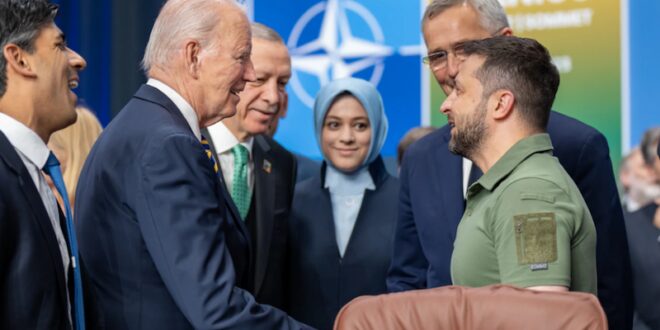(FPRI) — The North Atlantic Treaty Organization’s (NATO) heads of state and government participated in the meeting of the North Atlantic Council in Vilnius, Lithuania, in July — the fourth summit the Alliance has held since the full scale Russian invasion of Ukraine in February 2022. The top level gathering was hosted 20 miles from the border with Russian-allied Belarus, sending several important signals: This reiterated NATO’s concern with the war, underscored Western support for the Ukrainian cause, and reaffirmed deterrence for the Eastern Flank member states, including recently joined Baltic neighbor, Finland. The week of the summit also brought about the conditional accession of Sweden, after Turkey dropped objections.
Swedish and Finnish NATO membership has been long-awaited, especially in the Baltics, but it falls short of a miracle cure for the security risks the Eastern Flank faces. The key external factors that negatively affect Baltic security will continue into the medium-term future, even if the Swedish and Finnish governments have decided to forego their long-held neutrality. Specifically, the composition of nuclear, conventional, and asymmetric security challenges created by Russia are bound to remain the most significant threats to the Baltic area, as well as the broader Transatlantic space. This would be the case if either Russia survives the war and rebuilds its offensive capabilities, or if the state disintegrates into regional warlords, leading to an unavoidable and unwanted flow of Russian refugees across European borders. For Russia as a rational actor, any regional cooperation among its immediate Western neighbors makes it more difficult to achieve the regional power projection that is in its international interest. Regional cooperation within the NATO framework is the worst scenario for the Kremlin, so it can be expected to try anything that could impede closer NATO integration, especially in the Baltic region.
For Euroatlantic Baltic Sea security, Swedish and Finnish accession to NATO is more of a capstone of existing collaboration, rather than a significant change. Both countries have had a wide-ranging yet discrete bilateral defense cooperation with the United States and other Western nations since the Cold War. Similarly extensive, yet more transparent, has been Nordic-Baltic defense cooperation. Indeed, the Baltic states relied heavily on the Swedish and Finnish models as they reestablished their armies in the 1990s. The Nordic Defense Cooperation (NORDEFCO) institutionalized regional multilateral security efforts in 2009. Established after Russian aggression in Georgia in 2008, NORDEFCO covered some of the gaps in security policy cooperation for NATO (due to Sweden and Finland being outside the Alliance) and the Common Security and Defense Policy of the European Union (due to Norway and Iceland being outside the EU). Swedish and Finnish NATO membership is the upper limit of extending the different collaboration formats without changing the current national constitutional principles. The real added value of Swedish and Finnish accession to NATO lies in simplifying some of the complex ways the US and the Nordic and Baltic states have cooperated to provide security without eliciting Russian wrath.
The first direct benefit will be in systematic intelligence sharing. This follows the historical precedent of Finland benefiting from intelligence sharing with Estonia and Latvia with regard to the Soviet threat in the 1930s, helping Finland in the Winter War. Recently, examples such as the Nord Stream explosion (and its impact on the energy prices) as well as the Nordic security service reports on Russian “ghost ships” underscore the increasing importance, reliance, and vulnerability of critical infrastructure in contestable waters. This matters due to the highly integrated electricity, finance and natural gas markets of the Nordic and Baltic countries. Improving situational awareness would be difficult if the political status of cooperation remained as before, as the most valuable intelligence with the highest NATO secrecy classification could not be shared with states that are not members of the Alliance.
This further points to an important political and psychological benefit: NATO membership is clearly superior to other forms of NATO and non-NATO cooperation. This distinction had been made questionable by increasingly closer security cooperation between NATO, Finland and Sweden while the two Nordic states retained neutrality. As much as the Baltic states wanted better security cooperation with Sweden and Finland, the Baltic states also had the biggest reservations about what seemed to devalue all of the work it took Tallinn, Riga and Vilnius to get themselves into the NATO club. Lower hurdles to receive the same security benefits for Nordic countries that were already better situated than their Baltic neighbors raised eyebrows both among Baltic governments and their societies. Domestically, it was much harder for Estonia, Latvia and Lithuania to reach the standards required by NATO and it was electorally counter-intuitive for the Baltic governments to argue for the necessary national budget defense expenditures during the socially painful economic transition from the Soviet command economy to the free market in the 1990s and early 2000s. The Russian government further tried to use still-prominent economic interdependence to exacerbate this social cleavage in the Baltics, but was thwarted largely due to internal threats of separatism and the 1998 financial crisis. Still, the Russian government relied on former institutional contacts (former members of the communist party, the Soviet Army, and secret services like the KGB), which forced Baltic governments to refuse security clearances to many experienced defense specialists who did not meet NATO standards due to their vulnerability to Russian corruption and covert influence. Therefore, it was hard for the Baltic states to understand why Sweden and Finland would be provided NATO-equivalent security guarantees even when it would cost those countries so much less politically and economically to pursue full membership either in the 1990s or in this decade.
Improved air defense and naval defense is the next clear benefit of Finland and Sweden joining the Alliance. Denmark, Norway, Sweden and Finland already agreed to integrate their national air forces in March of this year; this was unaffected by the (then) lack of Finnish and Swedish NATO membership. As suggested in BSF research in 2021, with Finnish and Swedish accession to NATO, there is an opportunity to evolve tripwire NATO Air Policing into a more solid force for the Baltic region by further involving the Nordic countries and selecting one commander for an integrated air force from either Sweden or Finland. This arrangement would harness their expertise and guarantee continuous engagement. Safeguarding Baltic airspace would also provide strategic depth for Nordic air defense, making it a clear trade-off with the burden of the expenses being shouldered by the Nordic side in the short and medium term. Similarly, it would now be possible to establish a Baltic naval force under a Swedish or Finnish commander to provide solid maritime deterrence and surveillance. This would improve security for the Euroatlantic Baltic Sea states by covering key capabilities that are prohibitively expensive for the Baltic members, but are indispensable to prevent Russia from gaining a foothold in the Baltic states that would endanger the Nordics and control of the Baltic Sea. The deterrence gains with such an approach would be second to none.
Increasing the efficiency of the existing and evolving defense efforts will be more complex as a more detailed security policy is translated into defense capabilities that are nationally combined yet universally effective. The most difficult part of further defense cooperation and integration is going to be the lack of human resources. This has been a persistent issue for armed forces, not limited to the Baltic states. Military services have provided increasingly competitive remuneration, paid education and social benefits, progressively guaranteed in the long term by proportionally fixed national defense spending. However, problems associated with demography, public health, inter-European migration, trust in the government, disinformation and influence operations make this issue above the pay grade of the national defense departments alone. Therefore, retaining enough specialized service members to man long-range precision fire systems, air and missile defense and maritime domain awareness capabilities is going to need solutions beyond conscription, national investments and an effectively formal multilateral defense integration.
In the Vilnius NATO Summit, the Baltic states have achieved much of what is in their best security interest today, most importantly – the Finnish and Swedish integration in NATO. However, the Russian security threat is still likely to return to the region, even in the case of Kyiv’s military victory in the war in Ukraine. It will be in the best security interest of the Baltics to seek integrated defense solutions together with the full set of Nordic allies for the safety of the Baltic Sea region now that the Alliance is more focused on this part of Europe than ever before.
 Eurasia Press & News
Eurasia Press & News


